
Page under
copyright !
TO BE CONTINUED... Page 16 (second part)
Text by Nicole Bouglouan
Photographers:
Roger Ahlman
Pbase Galleries Peru and Ecuador
Didier Buysse
Vision d’Oiseaux
Steve Garvie
RAINBIRDER Photo galleries & Flickr Rainbirder
Ken Havard
My Bird Gallery & Flickr gallery 1 & Flickr gallery 2
Patrick Ingremeau
TAMANDUA
Niraj V. Mistry
Photo Galleries
Dubi Shapiro
Dubi Shapiro Photo Galleries
Callie de Wet
GALLERY
These images and the text are subject to copyright and cannot be used without express authorization from the owners. Legal issues
Sources :
HANDBOOK OF THE BIRDS OF THE WORLD Vol. 7 by Josep del Hoyo-Andrew Elliott-Jordi Sargatal – Lynx Edicions – ISBN: 8487334377
L’ENCYCLOPEDIE MONDIALE DES OISEAUX - Dr Christopher M. Perrins - BORDAS - ISBN: 2040185607
BIRDS OF VENEZUELA by Steven L. Hilty – Ed. Christopher Helm – ISBN: 0713664185
BIRDS OF PERU by Thomas S. Schulenberg, Douglas F. Stotz, Daniel F. Lane, John P. O’Neill, Theodore A. Parker III – Princeton University Press 2007– ISBN: 978-0-691-13023-1
SORA - LIFE HISTORY NOTES ON PUFF-BIRDS
Wikipedia, the free encyclopaedia
Bird nests: Variety is Key for the world’s avian Architects
Be on the lookout for bird nests
The design and function of birds' nests
CREAGUS@Monterey Bay (Don Roberson)
The bird and its nest, where everything starts…
Page 16 : Galbulidae, Bucconidae, Capitonidae, Lybiidae, Megalaimidae, Semnornithidae
First part
At the beginning of the breeding season and following several courtship displays, the nest-site is selected by the pair, or one of the members of the pair, and the nest is built within this area. For numerous species, the nest is the place where displays and copulation occur. It plays a very important role during the nesting period. It is the cradle of the chicks, the place where the adults feed them prior to their first flight towards independence.
The order Piciformes includes today nine families. The Galbulidae (Jacamars) and the Bucconidae (Puffbirds), formerly placed in the order Galbuliformes, are now included into the large order Piciformes. Both families occur in Central and northern half of South America.
The jacamars of family Galbulidea are small to medium-sized perching birds. They have slender body and rounded wings, and a long bill allowing them to catch insects in flight. They generally live in woodland and forest, mainly lowland habitats. They are mainly arboreal and often occur at the edges or in forest canopy.
They are conspicuous birds, flying fast when chasing a prey or moving from perch to perch. They are insectivorous and feed exclusively on winged prey caught in flight. However, the Great Jacamar also takes spiders and small lizards.

The jacamars are usually monogamous, but some species may breed in co-operative groups. The courtship displays involve song and courtship feeding by the male. It catches insects and removes the wings before to present the food to its mate.
Both mates Rufous-tailed Jacamar perch side by side during nest-building. The male bobs the head and swings the tail up and down while the birds sing together.
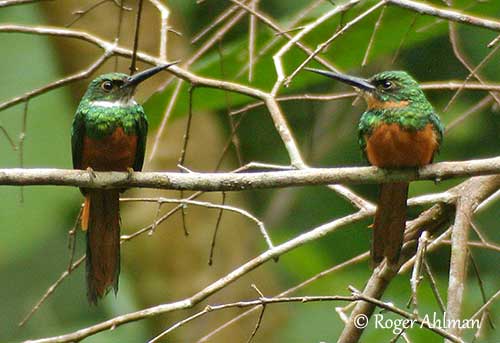
Male (left) and female (right)
The jacamars nest in cavities dug into soft substrate such as vertical earth banks, but nests are commonly found in termite mounds. Both mates dig with the bill, while debris is removed by kicking with the small, shovel-shaped feet. The female performs the bulk of this work, but she is fed by the male.

With prey
The nest-cavity is long and narrow, 29/50 to 80 centimetres or more, depending on the species. The nest-chamber is located at the end of the burrow. It is unlined, but the remains of insects regurgitated by the parents usually cover the floor as the nestling period is progressing.
The female lays 2-4 eggs and both adults share the incubation, performing some calling and displays at each change-over. The young fledge between 20 and 26 days after hatching.
The adults may clean the nest-hole and reuse it in several following years.
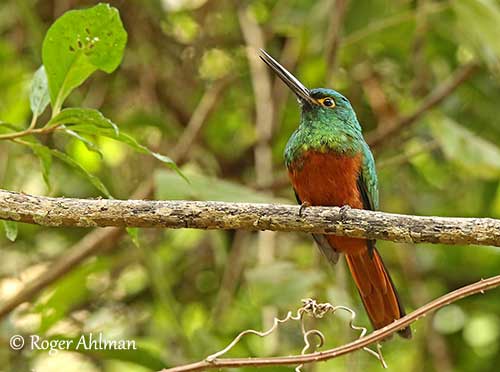
The puffbirds of family Bucconidae also are perching birds, but they have stocky body, short, rounded wings, bulky head, large eyes and a robust bill. They are associated with wooded habitats, and especially humid tropical lowland forest.
Their peculiar and frequent habit of fluffing out their plumage makes them almost similar to a ball, giving them the name “puffbirds”. But they have very fast and direct flight with rapid wingbeats.
They are mainly insectivorous, but spiders, scorpions, and other arthropods are also taken. However, the Swallow Winged Puffbird or Swallow Wing feeds exclusively on insects. It catches them by rapid aerial sallies from a perch, as a flycatcher. When the prey is caught, it returns slowly to the perch, performing undulations and circles before to back down to its perch. It often swallows the prey in flight. This species is known to hunt for smaller insects than other puffbirds’ species. Its main diet includes bees, wasps, alate termites and flying ants.
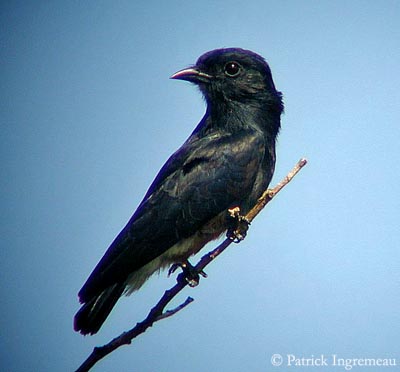
or Swallow Wing
Puffbirds are sedentary and territorial all year round. They are probably monogamous and most of them may live together as pair throughout the year. But some species are suspected to breed in co-operative system.
They nest in cavities and some of them use arboreal termitaria, while others nest in earth tunnels or in holes in trees. The Russet-throated Puffbird is known for taking sometimes the mud of the nests of Furnarius species, especially the Pale-legged Hornero.

When excavating the nest in termitaria, both mates usually take turns, and while one bird is working, the other keeps an eye on the surroundings. After two weeks of effort, the narrow, horizontal tunnel of about 18 centimetres in length leads to the rounded, unlined nest-chamber placed in the heart of the termitary. The eggs are laid on the debris, at the bottom of the cavity.
Ground nests are dug into flat or slightly inclining ground. The tunnels are straight with a nest-chamber at the end, lined with pieces of leaf. The Black Nunbird and other Monasa species pile up leaf parts, twigs and dead leaves to form a frame that blends with the ground around the nest entrance. Other species make a large pile of leaves and the tunnel is excavated under this mound of vegetation.
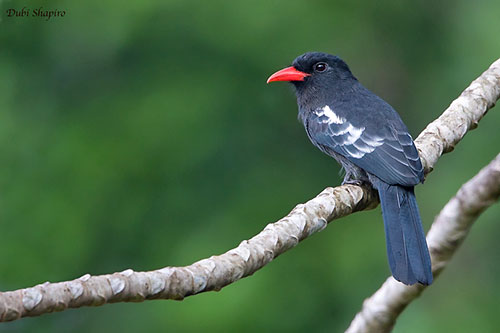
Like in most cavity nesters, the eggs are white and relatively small. Clutches of 2-3 eggs are common. Both adults share the incubation during about two weeks. The chicks hatch blind and naked, but the pin-feathers appear six day later. The chicks are similar to adults at 14 days old. They fledge between 20 and 30 days after hatching. They still depend on parents for food for at least a month, and it is suggested that they remain in family groups until the next breeding season.
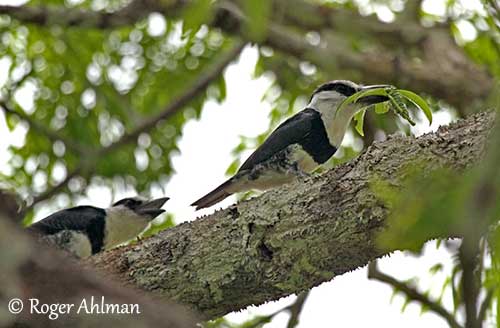
White-necked Puffbird
Carrying nest materials
The barbets of family Capitonidae are small to moderately large birds. They are robust, with strong bill and sharp claws. They are arboreal species.
The name “barbet” comes from the bristles that fringe their heavy bills.
Several changes occurred within this family. The subfamilies Lybiinae (African arboreal barbets) and Megalaimatinae (typical Asian barbets) have now their own families, Lybiidae and Megalaimidae. In the same way, the subfamily Semnornithinae (aberrant American barbets) with only one genus (Semnornis) and two species has now its own family, the Semnornithidae.
The family Capitonidae contains only two genera, Capito and Eubucco that are typical American barbets.
The Capito species occur in South American humid forests, whereas the Eubucco species are mainly found in the humid forests of South and Central America.
All Capito species are sexually dimorphic and stocky, with pale bills often black tipped. Their plumage is colourful, with black back in males. They are generally seen alone or in pairs. They feed on fruits and arthropods.

The Eubucco species are slightly smaller than previous, but they also are sexually dimorphic. The yellowish bill is stubby, and the plumage includes green back, yellow neck and underparts, and red on male’s head. They are usually observed singly or in pairs. They also feed on fruits and arthropods.
Both genera are arboreal. They nest in tree holes excavated by the pair and the female lays 2-4 eggs.
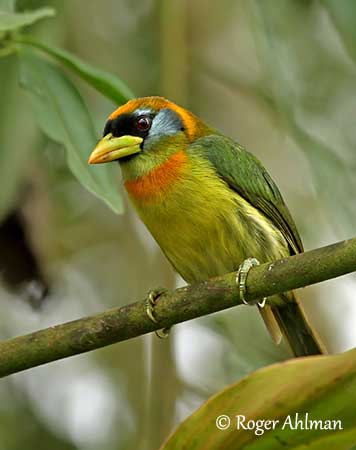
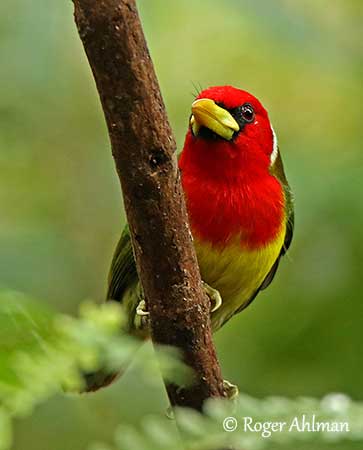
The family Lybiidae include the African Barbets and the Tinkerbirds in seven genera. They are found in sub-Saharan Africa. They frequent a large range of habitat types from the thick jungle where they occur in the canopy, to the open scrub where some of them can be seen on the ground.
The Lybiidae’s most usual feature is a stout, relatively short, pointed bill, not laterally compressed. The cutting edges can be smooth or irregular, like in the Bearded Barbet. This species shows ridged and grooved mandibles, with two strong “teeth” on the edges of the upper mandible.
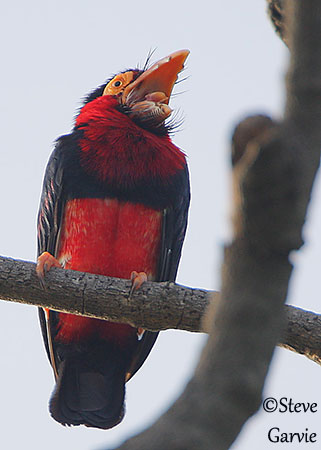
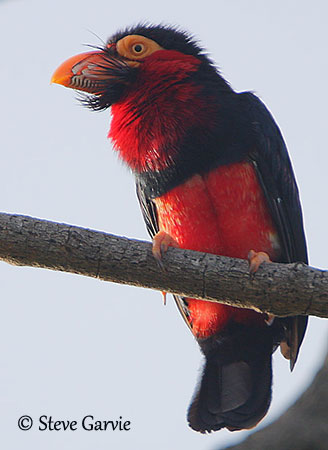
Their diet is closely related to their habitat. The forest birds feed primarily on fruits, whereas the birds of the scrubby areas feed mainly on insects such as termites and ants and several other species.
The Crested Barbet spends most of its time foraging on the ground, searching for food. It likes to bounce around the ground. It also forages in bushes and trees for insects and fruits. It probes into the bark crevices and among lichens, and may hang from the leaves for insects.
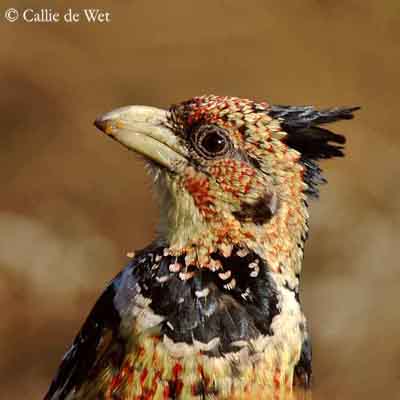
The nesting behaviour of many African barbets is unknown, but some species may nest in riverbanks or in termite mounds. Most of them dig a hole in tree and lay 2-4 eggs. Both parents share the nesting duties, including the incubation during 13-15 days.
However, the Red-and-yellow Barbet frequents mostly wooded savanna, rocky scrubs and gardens in East Africa. Unlike other barbets, this species nests on the ground. The cavity is dug in bank or termite mound, 1-4 metres above the ground. The nesting duties are shared by the pair and up to 8 helpers.
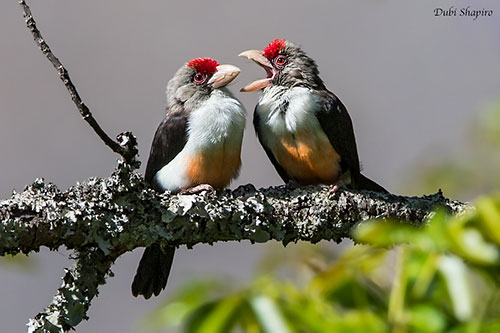
Brown-faced Barbet
Pair
The small tinkerbirds of genus Pogoniulus frequent forest, woodland and scrubland. They usually feed on fruits and insects. They are solitary and nest in pairs, and have a large repertoire of vocalizations. They are widely distributed in tropical Africa. They nest in holes excavated in tree, often on the underside of a dead branch, between 1 and 6 metres above the ground. The female lays 2-4 eggs and both adults incubate during about 12 days.
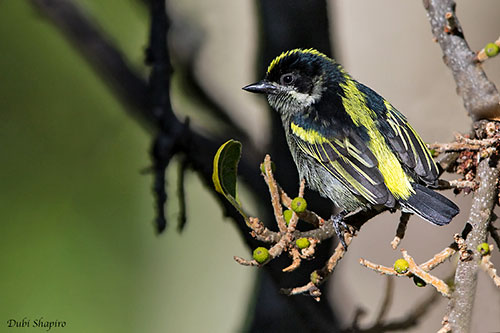
The family Megalaimidae comprises two genera, Psilopogon and Caloramphus. They are typical Asian barbets living in the forests of the Indo-Malayan region from Tibet to Indonesia. They frequent mainly inner forest, although the Coppersmith Barbet is usually found at forest edge and in scrub.
They are thick bill with bulbous shape, surrounded by stiff, rictal bristles. They are able to perch and climb easily while foraging, indicating their arboreal lifestyle.
These solitary birds feed on insects and fruits, especially figs of genus Ficus, but they may take fruits from more than 60 different families throughout the range. Barbets are important agents in seed dispersal through the tropical forest. Arthropods including a large range of insect species are gleaned from branches and tree trunks.
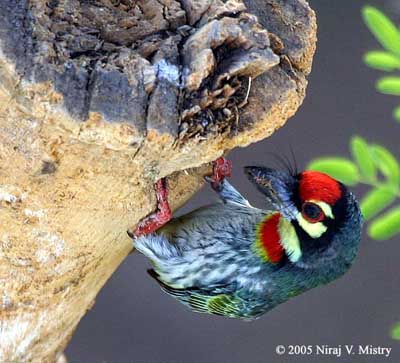
They are cavity-nesters, and the large nesting cavity is excavated in dead or soft wood, but other nesting holes are sometimes used is they are suitable. The nests can be sited at various heights above the ground, but most barbets usually nests fairly high up in trees.
The cavity is not lined, although the bottom is sparsely covered with wood-chippings after the building phase, but the birds remove most chips from the nest. The eggs are white and the incubation by both parents lasts about two weeks. The young fledge one month later.
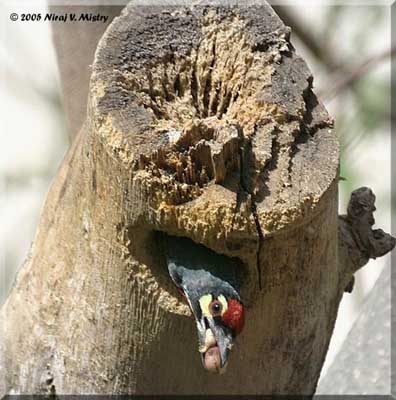
At nest entrance
The family Semnornithidae has only one genus: Semnornis. These two “aberrant” species are unique within the order Piciformes, in having the bill pronged at tip of the upper mandible, with this prong fitting into a notch in the tip of the lower mandible. The bill appears laterally “swollen” at the base.
The two species occur in S Central America and NW South America. They frequent wet montane forest and edges, and low bushy secondary forest with scattered tall trees, between 500 and 2,400 metres of elevation.
Both species show sexual dimorphism. The males exhibit glossy black, erectile nape feathers often used in courtship, whereas the females lack them.
They feed on numerous fruits from several plant families. They also take insects such as termites. They forage during several hours every day, hoping actively along branches from mid-level to canopy.
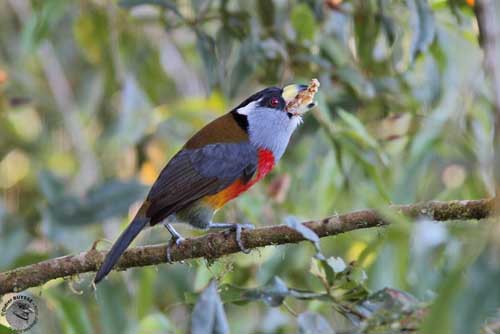
Female
The Toucan Barbet is monogamous and cavity-nester. They often form small groups such as trios or quartets, consisting of one pair and one or two young which co-operate in territory defence and assist the adult pair during the nesting period.
The nest is excavated in dead tree at about 1 to 5 metres above the ground. The cavity-entrance is adapted to the size of the species.
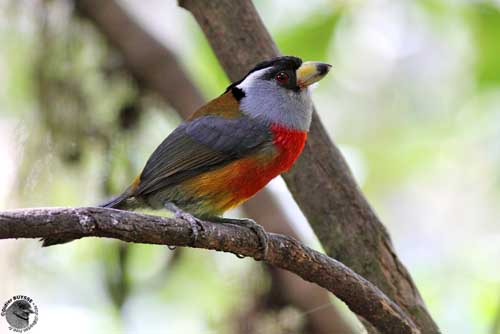
Male
The Prong-billed Barbet nests in territorial pair. The cavity is excavated in dead tree or dead branch in live tree. Both adults share the nesting duties and do not have helpers.
Both species lay between 2-3 to 4-5 white eggs and the incubation lasts about two weeks. The young forage and roost with parents and remain in family group for some weeks after fledging.